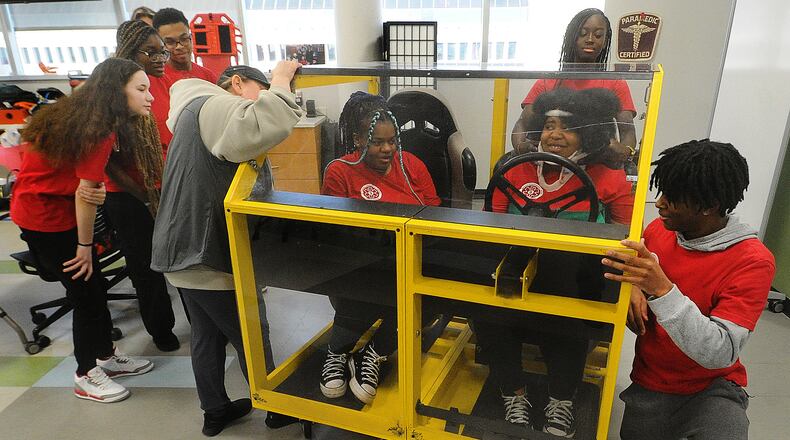Students who are 18 and successfully complete the program in May 2024 will be certified to begin working as EMTs — a step along the path to becoming a full paramedic. Younger students will become certified when they turn 18.
“When I trained 35 years ago, I was taught how to perform CPR and how to resuscitate babies on white mannequins,” said Chuck Sowerbrower, chair of Sinclair’s EMS department and a 35-year paramedic. “There was no such thing as African-American or Asian simulators, and I do think that flavors how you think about a profession and how you think about opportunities if you’re not seeing yourself in that mirror.”
Sowerbrower said Sinclair’s EMS program has never used any barriers for enrollment based on race or gender, but noted the department can do more to open up the playing field.
“We, as a profession, have done a bad job of trying to create an environment which is open and inclusive,” he said. “We tend to fall back on the fact that we don’t have any barriers preventing Black students from joining, but we haven’t been making it available, either, so there’s got to be that step forward.”
Trotwood-Madison City Schools biology teacher Justin Stone has worked with Sowerbrower to recruit students to the new program. Stone said he feels Black and minority students may simply not be aware of all of the options available to them.
“When you do well in school and you’re in an urban community, you’re typically pushed toward higher professions, like becoming a doctor, an engineer, or a lawyer, but no one really talks to us about the trades or EMS opportunities, even something as simple as saying, ‘Hey, you’d be a great electrician,’ ” Stone said. He added that some fields, like those based around emergency response, tend to run in families, with multiple generations seeking out these careers.
Eleven Trotwood-Madison students are enrolled in this year’s inaugural program. Students take an introductory EMS class at Trotwood-Madison High School during regular school hours — taught by Stone — followed by hands-on labs either on Sinclair’s campus or in Trotwood multiple times per week.
“The kids love it,” Stone said. “They’re at school from 8 a.m. to 5:30 p.m. Tuesday through Thursday, and they still show up, which just shows that they have the passion and perseverance to be here and to have this opportunity.”
According to the U.S. Bureau of Labor Statistics, overall employment of EMTs and paramedics is projected to grow 5% through 2032, with approximately 18,100 openings projected each year.
Sinclair typically produces anywhere from 120 to 140 EMT graduates each year, Sowerbrower said.
“Right now, there’s an insufficient number of providers to meet the job demand,” he noted, adding that the starting salary for a paramedic firefighter in the area is often between $50,000 and $60,000, depending on the department. “And that’s without a math course, an English class, or an associate degree, so it’s a great option.”
Joi Jones and Javion Long are seniors at Trotwood-Madison High School. Jones, 17, said she joined the EMS program after going on a field trip last year that introduced the new offering to students.
“To be honest, I was just going because it was a field trip and who doesn’t want to skip school? But when I actually started seeing what it was, it caught my attention, so I joined the classes this year and it’s been really fun,” Jones said. “I can’t wait to see where this class can take me further in my life.”
Long, 17, said he was looking for more hands-on opportunities and decided to give the EMS program a try.
“I came back from home school and my academic classes were really boring, so I used this to liven up my studies,” he said. “I like how interactive it is and it sparks your interests.”
Jones and Long are still deciding on whether EMS will be a long-term career for them, but both expressed appreciation to be given the opportunity to try it out.
“I never thought they would bring a program like this to Trotwood,” Jones said. “It seems like Trotwood’s always on the news for something bad, but I think this helps to show that there’s good here too.”
Long agreed, adding that the program offers more than just education.
“It’s a spark of hope,” he said. “It lets Black kids know that they can be something and they don’t always have to be weighed down by society’s standards.”
About the Author

